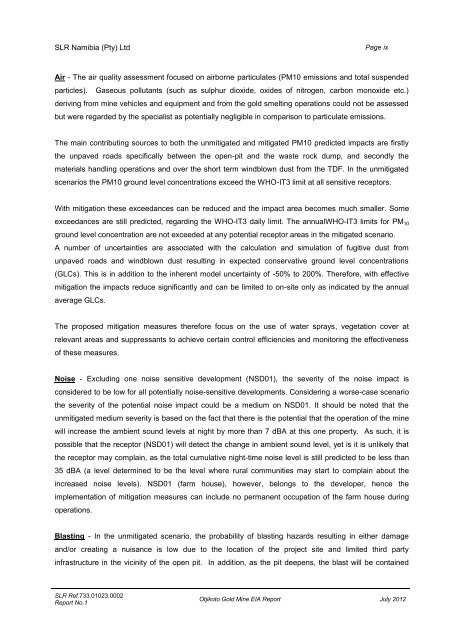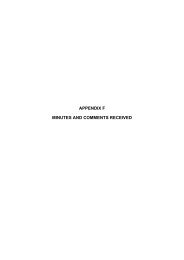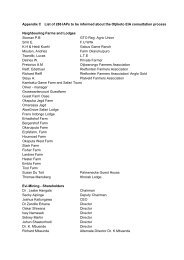2 Otjikoto Final EIA Report 5MB - Asecnam.com
2 Otjikoto Final EIA Report 5MB - Asecnam.com
2 Otjikoto Final EIA Report 5MB - Asecnam.com
Create successful ePaper yourself
Turn your PDF publications into a flip-book with our unique Google optimized e-Paper software.
SLR Namibia (Pty) Ltd<br />
SLR Ref.733.01023.0002<br />
<strong>Report</strong> No.1<br />
Page ix<br />
Air - The air quality assessment focused on airborne particulates (PM10 emissions and total suspended<br />
particles). Gaseous pollutants (such as sulphur dioxide, oxides of nitrogen, carbon monoxide etc.)<br />
deriving from mine vehicles and equipment and from the gold smelting operations could not be assessed<br />
but were regarded by the specialist as potentially negligible in <strong>com</strong>parison to particulate emissions.<br />
The main contributing sources to both the unmitigated and mitigated PM10 predicted impacts are firstly<br />
the unpaved roads specifically between the open-pit and the waste rock dump, and secondly the<br />
materials handling operations and over the short term windblown dust from the TDF. In the unmitigated<br />
scenarios the PM10 ground level concentrations exceed the WHO-IT3 limit at all sensitive receptors.<br />
With mitigation these exceedances can be reduced and the impact area be<strong>com</strong>es much smaller. Some<br />
exceedances are still predicted, regarding the WHO-IT3 daily limit. The annualWHO-IT3 limits for PM10<br />
ground level concentration are not exceeded at any potential receptor areas in the mitigated scenario.<br />
A number of uncertainties are associated with the calculation and simulation of fugitive dust from<br />
unpaved roads and windblown dust resulting in expected conservative ground level concentrations<br />
(GLCs). This is in addition to the inherent model uncertainty of -50% to 200%. Therefore, with effective<br />
mitigation the impacts reduce significantly and can be limited to on-site only as indicated by the annual<br />
average GLCs.<br />
The proposed mitigation measures therefore focus on the use of water sprays, vegetation cover at<br />
relevant areas and suppressants to achieve certain control efficiencies and monitoring the effectiveness<br />
of these measures.<br />
Noise - Excluding one noise sensitive development (NSD01), the severity of the noise impact is<br />
considered to be low for all potentially noise-sensitive developments. Considering a worse-case scenario<br />
the severity of the potential noise impact could be a medium on NSD01. It should be noted that the<br />
unmitigated medium severity is based on the fact that there is the potential that the operation of the mine<br />
will increase the ambient sound levels at night by more than 7 dBA at this one property. As such, it is<br />
possible that the receptor (NSD01) will detect the change in ambient sound level, yet is it is unlikely that<br />
the receptor may <strong>com</strong>plain, as the total cumulative night-time noise level is still predicted to be less than<br />
35 dBA (a level determined to be the level where rural <strong>com</strong>munities may start to <strong>com</strong>plain about the<br />
increased noise levels). NSD01 (farm house), however, belongs to the developer, hence the<br />
implementation of mitigation measures can include no permanent occupation of the farm house during<br />
operations.<br />
Blasting - In the unmitigated scenario, the probability of blasting hazards resulting in either damage<br />
and/or creating a nuisance is low due to the location of the project site and limited third party<br />
infrastructure in the vicinity of the open pit. In addition, as the pit deepens, the blast will be contained<br />
<strong>Otjikoto</strong> Gold Mine <strong>EIA</strong> <strong>Report</strong> July 2012





